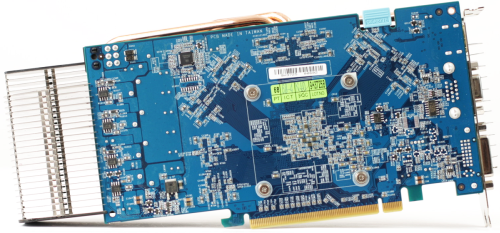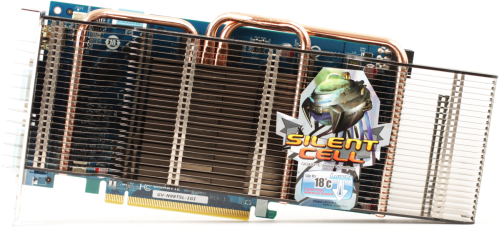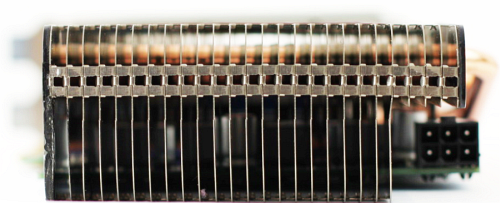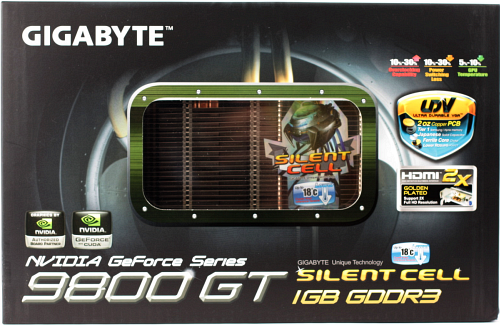

Review: When power and silence collide
Today we bring you Gigabyte’s 9800 GT Silent Cell, a unique graphics card which brings passive cooling to Nvidia’s 9800GT graphics chip. Of course, passively cooled cards are generally more basic cards and are not made with ultimate performance in mind, that task is rather left to the actively-cooled versions, but these cards have an ace up their sleeve - the golden silence. Gigabyte is of course not the first company to strap the 9800 GT with passive cooling, but are first to do so with Silent Cell cooling.
Silent Cell cooling uses multi-heatpipe technology with ultra-thin cooling fins which greatly help with heat dissipation. Gigabyte claims that thanks to the Ultra Durable ower components and Silent Cell cooling on their card, it will run more stable and up to 18°C cooler than the reference card, which as you know comes with air cooling. The picture below shows the GV-NV98TSL-1GI in all its glory (you can view pictures in higher res if you’d like, courtesy of our own Eliot Kucharik, just click on the pics).
The passive cooling solution is pretty big, even bigger than the card’s PCB. The total surface of the aluminum fins is pretty impressive, but there was simply no other way as the cooling has to be flawless on passive cards. The card is dual-slot width, allowing the aluminum fins to stretch all the way to the I/O panel, where they’ll peek out of your computer.
The three copper heatpipes are responsible for quick temperature transfer from the core to the cooling fins. The following photo clearly shows that designing while designing Silent Cell cooling , Gigabyte’s team made sure to use every single inch of free space around the card, in order to maximize dissipation surface of the cooler. You can clearly see the cooling that stretches over the entire length of the card’s PCB, ending with the PCI-Express power connector. Note that Geforce 9800 GT requires one 6-pin connector, and by thinning out the cooler above the PCI-E connector, Gigabyte made sure that plugging the card’s power in isn’t a cumbersome task.
It’s very important to note that the card’s performance will greatly depend on your rig’s airflow, as a decent airflow is a prerequisite for any passive cooling, graphics or other.
The photo above shows the copper pipes starting their journey from within the large copper base. The copper base covers the GPU and three of eight memory modules. Gigabyte didn’t chose to apply cooling to all the memory modules, as the memory runs at 900MHz despite being rated at 1GHz, which leaves space for overclocking. The Silent Cell’s large copper base is one of the main reasons behind its cooling efficiency.
The back of the card is pretty uninteresting, but it paints a picture about the size of Silent Cell cooling. The GV-N98TSL-1GI, as the name suggests comes with 1GB of GDDR3 memory and all the memory modules are placed on the GPU side of the PCB. The memory on this card is Samsung K4J10324QD-HJ1A.

In case SLI is your weapon of choice, Gigabyte’s card can easily be chained up with another 9800GT card. The SLI connector kept its standard place, and Gigabyte used a protective cap, similar to the ones on the video outs.
The GV-N98TSL-1GI comes with a dual-link DVI connector, VGA connector and a gold plated HDMI connector. In order to get sound and video all via one HDMI cable, you’ll need to use the SPDIF cable, something owners of Nvidia cards are pretty familiar with. Those who are not can refer to a special manual Gigabyte made especially for their Silent Cell graphics card.
The following photo shows the view from the other side of the graphics card, where you can see the freed up space for easier access to the power connector.
The GV-N98TSL-1GI’s clocks were left unchanged from the reference 9800GT values – 600MHz GPU, 900MHz memory and 1500MHz shaders. The reference clocks are a wise thing to do, as some users might not heed the “mind the airflow” warning and if the card had been overclocked it would’ve posed a serious problem. The card ran stable throughout our testing, and although the temperatures have indeed been lower than on the air-cooled 9800GT cards, turning off the case fans resulted in a steep temperature climb. You can find out more about this card’s thermals later on.

Although GPU-Z reports the GV-N98TSL-1GI to come with a 65nm graphics core, we took the cooler off and found out this is indeed the new 55nm G92 GPU (G92-283-B1) core which is more efficient and runs much cooler.
The 9800GT Silent Cell came in a pretty but durable box. You can see the card through the plastic window on the front and find out a couple of important info, such as Ultra Durable VGA components. In case one DVI connector isn’t enough, Gigabyte ships a HDMI-to-DVI converter, which is a great touch as it’s a rare gift with graphics cards that come with default HDMI out.
TestBed
Motherboard: MSI P45D3 Platinum ( Provided by: MSI );
Processor: Intel Core 2 QX9770 Extreme edition at 3.6GHz ( Provided by: Intel );
Memory: Corsair Dominator 12800 7-7-7-24 ( Provided by: Corsair);
HDD: WD VelociRaptor 300G 10,000RPM ( Provided by: SmoothCreation );
Driver: ForceWare 190.62, Catalyst CCC 9.8 Vista 32 SP1
Futuremark Tests
Gigabyte GV-N98TSL-1GI starts nicely in 3DMark06, where it scores almost as well as the HD 4850 graphics card. The reference 9800 GT with 512MB of memory was noticeably slower than the Gigabyte 1GB card in Futuremark tests , as the reference card lagged behind by up to 13.9%.




Gaming
Far Cry 2
FarCry 2 shows that GV-N98TSL-1GI’s additional memory brings significant frame advantage over the reference 9800GT as well as competing Radeon cards which ended up slower in antialiasing tests. Gigabyte’s card beats the reference card by 65.7% better result at the highest resolution, but shows its strong side at lower resolutions as well by up to 15.2%.






HAWX
HAWX shows the advantage of additional memory as well. The highest tested resolution, 2560x1600 was unplayable, but it clearly shows the superiority of Gigabyte’s card over the reference one. On the other hand, HAWX has DX10.1 support, something Nvidia’s card lacks, so turning it on resulted in Radeon cards winning the test.






Left 4 Dead
Left 4 Dead shows that Gigabyte’s card is far ahead of the reference card when antialiasing is on.






World in Conflict
World in Conflict also reports Gigabyte Silent Cell as better than the reference 9800GT, despite the fact that it too runs at reference clocks. GV-N98TSL-1GI scores up to 16.65% better results, most likely due to two times more memory than on the reference card.






Overclocking, Temperature i Potrošnja
Gigabyte prepared a little treat for 9800GT Silent Cell owners – the Gamer HUD Lite tool, which can be used to change the GPU, memory and shader clocks. We tried this tool and easily reached 725MHz GPU, 1750MHz shader and 1030MHz (2060MHz effectively) for the memory. Note however that the fans within our Cooler Master ATCS 840 were all on.

Idle temperatures were excellent, only 36°C, whereas operating temperatures weren’t bad either as temperatures didn’t go over 56°C. We couldn’t help but try the same test with our case fans off, and the card quickly hit 100°C when we had to stop our test for safety reasons.

After overclocking, the temperatures hit 60°C whereas idle temperatures were about 40°C.
Our rig in total consumed about 220W during operation and about 90W in idle mode. Such low idle consumption is a result of Nvidia’s dynamic consumption regulation, which downclocks the core, shaders and the memory when the card isn’t in 3D mode. AMD unfortunately doesn’t have this, as Radeons only downclock the GPU in 2D mode, resulting in higher consumption.
Conclusion
Gigabyte has come up with one of the best passively cooled graphics cards. Geforce 9800GT Silent Cell, or GV-N98TSL-1GI if you like codenames, will offer nice gaming potential with no noise whatsoever. This card didn’t let us down in overclocking tests either, as it has proven to be every bit as potent as air-cooled Geforce 9800GT cards. Gigabyte claims that Silent Cell cooling on the GV-N98TSL-1GI will result in up to 18°C lower temperatures on the reference Geforce 9800GT, and we almost hit that number during our testing. Note however that smaller and cramped cases will definitely affect the quality of passive cooling on any card, so make sure the airflow within your case is as good as possible.
Gigabyte GV-N98TSL-1GI comes with Ultra Durable VGA components which ensure stability and with 1GB of memory, which will as you can see definitely add to the gaming experience. The card has a native HDMI, which is great in case HTPC is what you’re after. Note that this card is slightly longer than the reference 9800GT, but isn’t awkwardly designed and the cooling will not hinder other slots or components. The GV-N98TSL-1GI follows the standard shape of a dual-slot card and will fit in any case capable of housing a GTX 260 or any other high-end card.
We had a chance to see and discuss the GV-N98TSL-1GI back in Cebit, and we must say that Gigabyte delivered on everything they promised. You can find it priced at about €110, which is some €30 more than the cheapest 9800GT card. If you’re looking for a card that brings quality performance and silent operation in one package, then look no further as this card is what you’ve been looking for.





